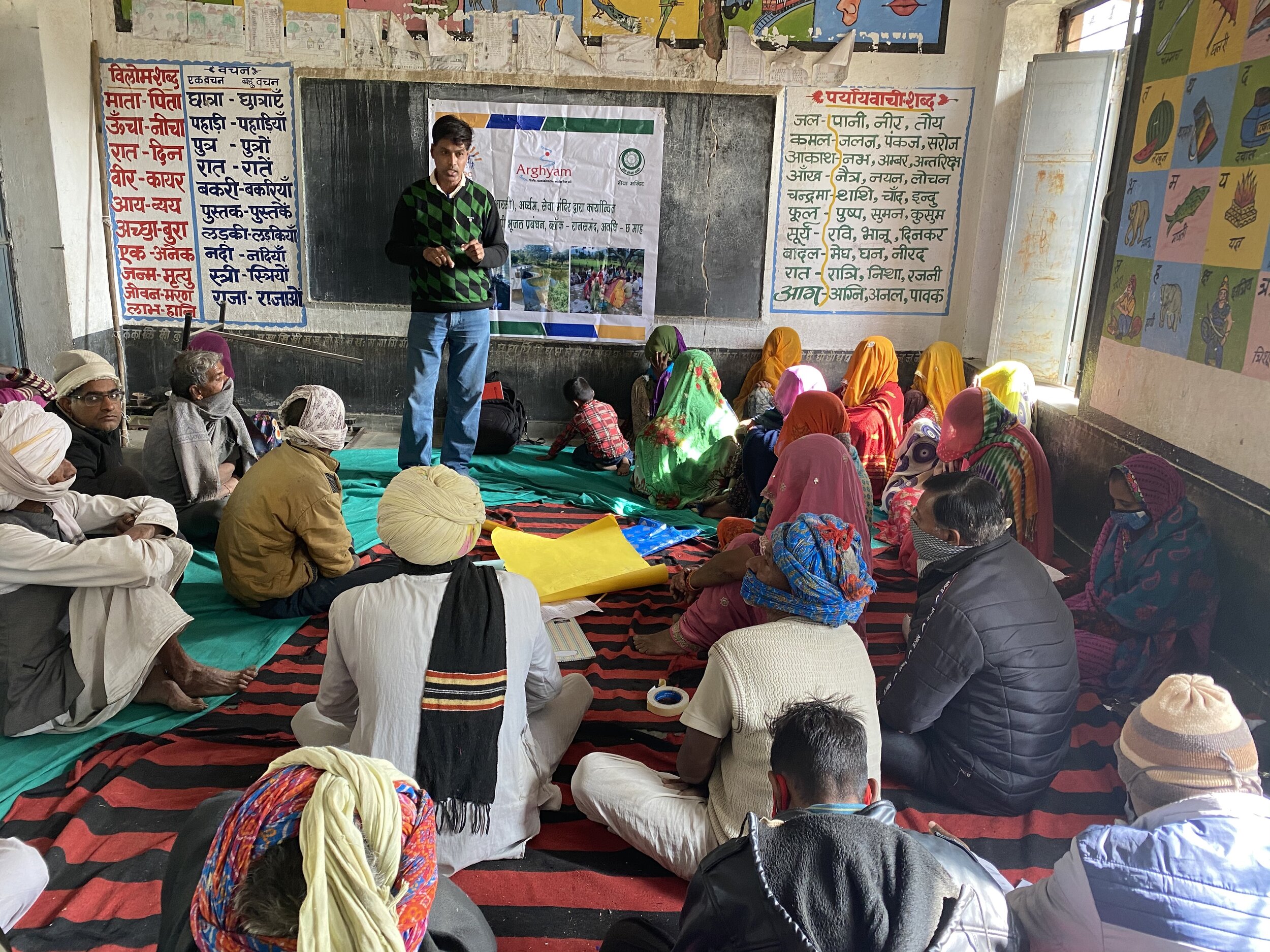Tasol Diaries
Wahhh! I’m finally here, at my final project location! And here’s a quick summary of my first few weeks here! As a refresher, here’s what’s going on:
NGO: Seva Mandir
This is the NGO I’m partnered with. It is based out of Southern Rajasthan and currently helps around 600 villages in all aspects of their lives, from education to livelihoods to community forest protection to women empowerment.
Village: Tasol, Rajsamand, Rajasthan
The local cluster office is based out of a small village named Tasol. The district is Rajsamand, which is a heavy marble mining area, leading to lots of water pollution and water scarcity in the area.
My project: Livelihoods of the local farmers
More on this later. 🤓
My apartment
It’s a tiny room in an old house. A really nice family lives in the room next door and the crabby old landlord lives upstairs with his wife.
The Tasol Office
One of the newest Seva Mandir branches, the Tasol office serves needs in Kankroli, Rajsamand and focuses on women's self-help groups and natural resource development (NRD) projects. The structure itself, a humble two-room building in which four people work, is located in an off-beaten path along with marble cutting shops. Rajsamand is mineral-heavy and is one of India's primary suppliers of marble, granite, and other stone materials. This, paired with its low education and female literacy rates, form the challenging landscape in which members of Seva Mandir in this region work in.
The Tasol Staff
Shankar ji and Prabhu Lal ji are dedicated to natural resource development (NRD), convincing villagers to develop their fields and protect their natural resources in the face of all the local marble mining. They face strong resistance due to the short-term profit that marble mining promises.
Gayatri ji and Hemlata coordinate the local women's self-help groups (SHGs), which work as self-directed banks, where women contribute a small sum every month and give personal loans to women who would not be able to get bank loans.
Shankar Singh
Block coordinator.
The man in charge, Shankar ji oversees NRD projects and keeps an eye on everything else.
Prabhu Lal Patiya
Block coordinator.
Soft-spoken and humble, Prabhu Lal ji is the wizard of all things NRD-related.
Gayatri Chouhan
Program associate.
Gayatri ji is instrumental in the daily ongoings of all projects and runs many women's self-help groups in the region.
Hemlata Kumawat
Lead paraworker.
An absolute firecracker, Hemlata helps Gayatri ji manage SHG meetings and helps train new paraworkers.
The Farmers
Here are some of the local farmers I’ve had the absolute pleasure of speaking with. The following three are stellar partners of Seva Mandir, eagerly participating in new programs, experimenting with new farming methods as well as reviving old traditional practices, and helping train other farmers.
Meeting Sipra Devi was purely a happy accident. After accepting an invitation for chai from a paraworker, I ended up at Sipra Devi's house, who happened to be the paraworker's mother-in-law. Sipra Devi insisted I spend the night there, visit their fields in the morning, and leave after breakfast, which I happily obliged to.
Located in Khatamla, Sipra Devi's extended family owns four small plots of land that they've dedicated to growing marigolds and broccoli, per Seva Mandir's guidance. They had never heard of broccoli before but, after farming it for the first time three years ago, have realized its high value in the market (as well as its delicious taste at home).
For Sipra Devi ji, the issue has been getting the right price. The price of broccoli in her local markets are 20-30 INR per kg. In nearby Udaipur, the price can go as high as 190-300 INR per kg in the restaurants and hotels that attract international tourists. Sipra Devi ji has requested help in getting her produce from her village to these better markets, which she currently has no means to.
Sipra Devi
The matriarch of a family that started Seva mandir's floriculture and horticulture project three years ago, Sipra Devi discusses the issues with pricing her produce.
Shyam Lal Mali
A rockstar farmer in Emri, Shyam Lal ji has taken full advantage of the popularity of farming broccoli in his village.
Amongst farmers who were unable to find good prices in local markets, Shyam Lal ji took all of the broccoli harvested by 47 families in Emri and sold it in Udaipur at 80 INR/kg, one of the highest prices yet for a Seva Mandir broccoli farmer. This has earned him that nickname of "the broccoli guy" across his village.
His process and learnings present a great opportunity for Seva Mandir to scale across other farmers and locales. After seeing his success, many more farmers in Emri now want to farm broccoli. Caste dynamics negatively impacted the Emri farmer group when Seva Mandir first set up its nursery here. However, the success of farmers like Shyam Lal ji and the potential for a significant boost in income has convinced people to work across the caste divide.
“This is the first rule of nature. You can ask a man for forgiveness and he will grant it to you. But you water the land a little late or give it too little water, it does not matter how much you beg for forgiveness later, it will never forgive you.”
Amba Lal Ghadri
Devoted to organic and indigenous farming techniques, Amba Lal ji of Rail Magra has grown broccoli for the past few years and is now looking for the next big idea.
The Engineers
Keshu Lal ji and Tulsi Ram ji are some of the engineers from Seva Mandir’s head office in Udaipur who visit us occasionally to ensure everything is running smoothly and to kickstart new projects.
Tulsi Ram ji is currently heading the bhoojal (groundwater) component of Rajsamand's livelihood projects. The next phase of the project will include raising awareness of saving water in the region and creating a water security plan as certain parts of the region are expected to run out of water.
Keshu Lal ji has been instrumental in water conservation work in the region, having lived here a few years ago. He has helped design and build several tanks (including the one pictured above), as well taken part in deepening lakes to increase water storage capacity during monsoon season.
Tulsi Ram ji
Explaining how to map out traditional water sources to villagers
Keshu Lal ji
Checking to make sure a Seva Mandir tank has been filled from the local river
The Water Warrior
As we ramp projects to conserve water in the region, we are relying on elderly members of the community to understand and record the traditional water landscapes, storage systems, and processes of the area. One such member is Parsuram Paliwal of Parwat Kheri, a local village that is facing immense water issues. He tells us what the local lakes and rivers used to look like and how they have dried up over time.
Parsuram Paliwal
Steeped in indigenous technical knowledge of water sources, Parsuram ji begs us for water preservation in Parwat Kheri.
The dry land where he is standing in this photo used to be a flowing river.
The community of Tasol and Kankroli at large has been friendly and extremely interesting to get to know. Language has posed an issue (most people here speak only Mewari) but I’ve been able to get by with my godawful Hindi.
It feels incredible to finally bite my teeth into the nitty-gritty of the community and get started on my project (which I will outline soon). I’ve already experienced so many emotions here: loneliness after not being able to properly communicate with people in languages I’m fluent in, being intimidated and overwhelmed by the amount of work there is to do, endlessly grateful and lucky that I get to be here, and everything in between.
Thank you for following my journey so far, this is just the beginning.












































